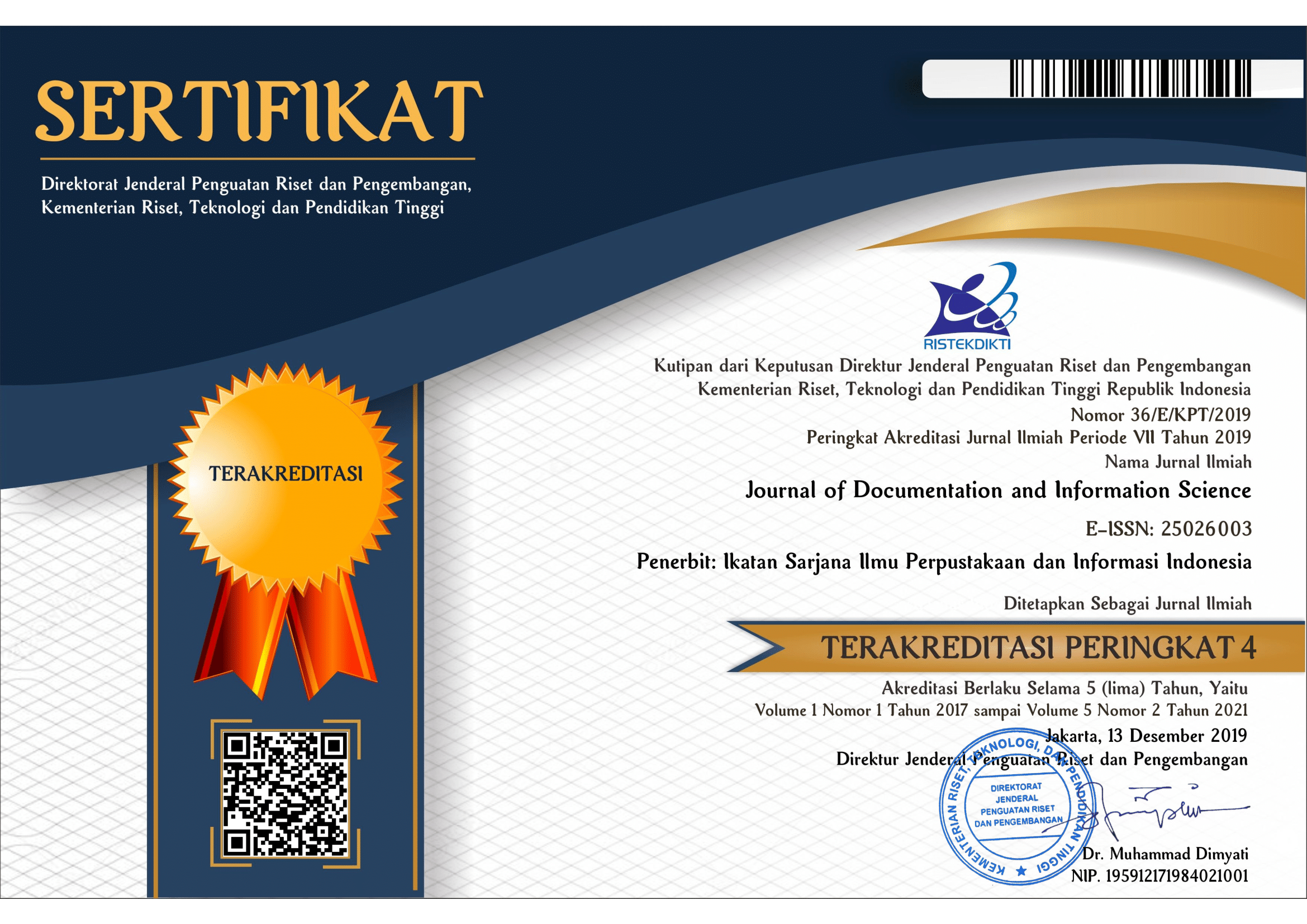SOCIETIES EXPECTATION AND LIBRARY VALUES: CONTENT ANALYSIS OF THE MOVIE “SMART LIBRARY MAKES SMART PEOPLE"
DOI:
https://doi.org/10.33505/jodis.v2i1.40Keywords:
Societies’ expectation, Libraries’ values, Smart library, Smart people, MoviesAbstract
Library services are now becoming very important as mandated by law no. 43 the year 2007, in article 14 (1) that library services are primed and oriented to the interests of the user. From that article, the role of librarians is essential in improving services. This study aims to determine the content of the messages available on a movie with title “Smart library makes smart people” especially the signal related to societies’ expectation to the library and the value that can be given by librarian to the users. The method used in this research is using content analysis. The research subject is a documentary movie produced by UPT Balai Informasi Teknologi-LIPI, Bandung, Indonesia, in 2015. The results showed that societies’ expectations could be seen at minute 11:18 of the movie that librarian cannot just expect societies to come to the library, but the library has to come to visit them. One of the vital source of strength, the formation of a nation the role-played by print culture. By reading might get some ideas and how to fulfill the plans. Because reading is a kind of bridge to the future. Other users expect at minute 15:46 that there is new technology, the library must move from old-fashioned to the electronic library. The original problem is about big data, but big data is critical to the future. The value that can be given to the users can be seen at minute 09:45 library has assisted to the provinces in Indonesia more than 600 mobile libraries. For the outer island, there are seven free libraries. In Jakarta, there is a Pusteling, a library and an electronic mobile completed with the laptop and internet. At minute 05:40 it is essential to be a growing library, the librarian must have innovation, creativity, and love of work, if there is no innovation from the librarian, there will be no innovation, no new services, and the library will be stagnant, traditional, no improvement.References
Baki, A. (2017). Content Analysis of Curriculum-Related Studies in Turkey between 2000 and 2014, 877–904. https://doi.org/10.12738/estp.2017.3.0002
Bengtsson, M. (2016). How to plan and perform a qualitative study using content analysis. Journal Homepage: Www.elsevier.com/locate/npls Research, 2, 8–14. https://doi.org/10.1016/j.npls.2016.01.001
Brannon, S. (2017). A Successful Promotional Campaign : We Can ’ t Keep Quiet About Our Electronic Resources, 1095(July). https://doi.org/10.1300/J123v53n03
Brooks, W. M., Mcnair, J. C., & Race, H. Á. (2015). “‘ Combing ’” Through Representations of Black Girls ’ Hair in African American Children ’ s Literature. Children’s Literature in Education, 46, 296–307. https://doi.org/10.1007/s10583-014-9235-x
Brown, J. M. (2011). Demonstrating Library Value: Examples and Applications for Arts Libraries. Art Documentation, 30(1).
Collins, J. (2005). Schools library services : their changing value to the education of London â€TM s children. Hi.story of Education, 34(1), 61–76. https://doi.org/10.1080/0046760042000315309
Davidson, K. S., Rollins, S. H., & Cherry, E. D. (2013). Demonstrating Our Value : Tying Use of Electronic Resources to Academic Success. The Serials Librarian, 65, 74–79. https://doi.org/10.1080/0361526X.2013.800630
Gann, Laurissa B., G. F. P. (2013). Using library search service metrics to demonstrate library value and manage workload. J Med Lib Assoc, 101(July), 227–230. https://doi.org/http://dx.d0i.0rg/i0.3163/1536-5050.101.3.015
Hossain, M. J. (2014). A Study of the Causes of User Dissatisfaction in Academic Libraries : A Case of University. Journal of Library Administration, 54, 462–482. https://doi.org/10.1080/01930826.2014.953386
Hwang, S. K. (2013). Home movies in participatory research : children as movie-makers. International Journal of Social Research Methodology, 16(5), 445–456. https://doi.org/10.1080/13645579.2012.729796
Jackson, B. (2017). The Representation of Library Value in Extra-Institutional Evaluations of University Quality. Canadian Journal of Higher Education, 47(1), 80–97.
Kenefick, C., & Devito, J. A. (2013). Google Expectations and Interlibrary Loan : Can We Ever Be Fast Enough ? Journal of Interlibrary Loan, Document Delivery & Electronic Reserve, 23, 157–163. https://doi.org/10.1080/1072303X.2013.856365
Lash, M. T., & Zhao, K. (2017). Early Predictions of Movie Success : The Who , What , and When of Profitability. Journal of Management Information Systems, 33(3), 874–903. https://doi.org/10.1080/07421222.2016.1243969
Lee, S. (2016). Comparative analysis of library marketing studies in Korea and other countries from 2000 to 2013. Malaysian Journal of Library & Information Science, 21(3), 71–93.
Macnamara, J. (2003). Media content analysis : Its uses; benefits and best practice methodology. Asia Pacific Relation Journal, 6(1), 1–34.
Marshall, J. G. (2007). Measuring the value and impact of health library and information services : past reflections , future possibilities leaders emerged from that environment including. Health Information and Libraries Journal, 24, 4–17. https://doi.org/10.1111/j.1471-1842.2007.00750.x
Mcgeachin, R. B., Ramirez, D., & Ramirez, D. (2017). Collaborating with Students to Develop an Advertising Campaign Collaborating with Students to Develop an Advertising Campaign, 1316(July). https://doi.org/10.1300/J106v12n01
Meyer, J., & Worster, A. (2015). Literary and Film Interests in Assisted-Living Residences : A Midwestern Study. The Reference Librarian, 56, 196–204. https://doi.org/10.1080/02763877.2014.1002364
Munson, K. I., & Savage, D. (2013). Interlibrary Loan ’ s Efficacy in Meeting Students ’ Expectations to Acquire Textbooks : Research Library. Journal of Interlibrary Loan, Document Delivery & Electronic Reserve, 23, 191–200. https://doi.org/10.1080/1072303X.2014.890151
Neal, J. G. (2009). What Do Users Want ? What Do Users Need ? W ( h ) ither the Academic Research Library ? Journal of Library Administration, 49, 463–468. https://doi.org/10.1080/01930820903089104
Nkosi, D., Leach, A., & Hoskins, R. (2012). Academic staff expectations of undergraduate students with respect to their use of the library at the University of KwaZulu-Natal , Pietermaritzburg Campus. SA Jnl Ubs &. Info Sci, 78(2), 79–88.
Oliphant, T., & Oliphant, T. (2017). “ I ’ m a Library Hugger !”: Public Libraries as Valued Community Assets “ I ’ m a Library Hugger !”: Public Libraries as. Public Library Quarterly, 33(4), 348–361. https://doi.org/10.1080/01616846.2014.970431
Redinata, I. W. (n.d.). CONTEXT OF SITUATION ANALYSIS IN THE KID MOVIE DORA THE EXPLORER I Wayan Redinata English Department, Udayana University. http://download.portalgaruda.org/article.php?article=13734&val=937.
Rusk, M. D., & Cummings, E. (2011). Libraries and the Local Economy : Partnerships for Economic Growth ( A Presentation to the Oklahoma Library Association , March 30 , 2011 ). Community & Junior College Libraries, 17, 53–61. https://doi.org/10.1080/02763915.2011.591708
Sengul, E. B., Emery, S. C., Fleming, C. T., Hartman, L., Hill, C. E., Stone, C. B., … Shaw, D. (2017). Movies in Public Libraries : A Checklist Comparison with Internet Movie Database Recommendations Movies in Public Libraries : A Checklist Recommendations, 6846(July). https://doi.org/10.1080/01616846.2012.732496
Thompson, B., & Cook, C. (2007). User library service expectations in health science vs . other settings : a LibQUAL +® Study. Health Information and Libraries Journal, 24, 38–45. https://doi.org/10.1111/j.1471-1842.2007.00744.x
White, D., & White, D. A. N. (2017). The Rural Library Project : Building Libraries , Building Community The Rural Library Project : Building Libraries ,. Public Library Quarterly, 33(2), 108–120. https://doi.org/10.1080/01616846.2014.910721
Downloads
Published
Issue
Section
License
Copyright (c) 2018 Journal of Documentation and Information Science

This work is licensed under a Creative Commons Attribution-NonCommercial-ShareAlike 4.0 International License.
- Hak publikasi dan pemanfaatan karya intelektual pada jurnal ini menjadi milik penuh penerbit, sedangkan hak moral menjadi milik penulis.
- Aspek legal formal akses dan pemanfaatan setiap artikel JoDIS tunduk di bawah lisensi Creative Commons Atribusi-Berbagi Serupa (CC BY-SA), yang berarti bahwa konten jurnal dapat dimanfaatkan secara bebas dan wajar (fair use) dalam bentuk serupa bahkan untuk kepentingan komersial.
- Untuk menghindari tindakan malpraktik publikasi dan plagiarisme penerbitan artikel, penulis diminta mengisi dan menandatangani pernyataan hak cipta pada Surat Pernyataan Keaslian Naskah dan Copyright Transfer.




